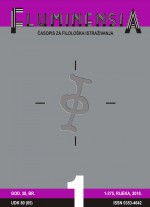OVERABUNDANCE IN CROATIAN DUAL-CLASS VERBS
Keywords:
overabundance, competition, verbal inflection, suppletion, phonological distance, Croatian languageAbstract
Croatian verbal inflection morphology is typically described using verb class distinctions. The number of classes differs among approaches, but the basic criterion for class division is the presence or absence and the type of suppletion in verb stems. Generally, one verb belongs to one inflectional class or paradigm only. However, some verbs belong to two classes, i.e. they have two parallel sets of stems. In such dual-class verbs, one infinitive form is realizable in two present forms in all cells within a class, i.e. there is an overabundance (Thorton 2011). Inevitably, one of the stem forming paradigms is a class with categorial suppletion. The present stem of a categorial suppletion class has a greater phonological distance from the infinitive stem than the present stem of the other class. Using a different terminology one class can be described as more transparent, while the other is less transparent (more opaque) in forming the present stem.
This study attempts to present overabundance in dual-class verbs and to determine whether competition in such forms can be explained by their tendency to conform to one default class or by other factors, specifically, by the phonological distance between the two paradigms of dual-class verbs. More than 90 dual-class verbs were retrieved from various sources, several dictionaries of the Croatian language and several corpora. Approximately half of the verbs were confirmed as dual-class verbs both in a dictionary and in at least one corpus. There are, however, verbs that were confirmed as dual-class verbs only in corpora – more precisely, in the web-based corpus hrWaC. Since they were attested as dual-class verbs only in corpora, they were treated as dual-class verbs that do not belong to the standard language base, but rather to sub-standard variants. They were therefore treated as a separate group in further analysis. While some dual-class verbs are more frequent in their non-suppletive class, others show preference towards the suppletive class, thus showing that the simplification of the paradigm towards the default class should not be considered the only guiding factor in the competition.
Two factors were examined as possible predictors of class preference: frequency and phonological distance. Overall verb frequency was calculated in the largest corpus available, hrWaC, using the lemma search. Phonological distance was calculated for each verb using the procedure based on Levenshtein distance (Levenshtein, 1965). The distance is calculated on the basis of three operations: insertion, deletion and substitution, as described in the literature (overview and validation: Sanders and Chin, 2009). Only phonological distance was found to be a predicting factor of class preference.
These results point to two conclusions. First, they seem to speak in favour of the postulate of the theory of Natural Morphology, which states that unnatural language phenomena (suppletion included) occur more frequently in inflectional languages. Second, they can corroborate the claim (Dressler 1999) that strongly inflectional languages often have no default, or only a weak default, among competing morphological patterns. However, it is important to state that, within this theoretical framework, it has also been predicted that suppletion would be among the least transparent phenomena, and thus the most unnatural (weak suppletion being only one level lower on the scale than strong suppletion). This seems to suggest that verbs with greater phonological distance would more often appear in the non-suppletive class rather than the forms with less phonological distance.
Due to the relatively small amount of variance explained, additional factors will have to be considered in order to describe the variability in dual-class verb preference. Factors such as the frequency of the verb class, the number of verbs per class, frequency within a cell, and phonological conflicts arise as potential candidates. Also, more recent approaches to phonological distance use phonetic correlates instead of phonemes to determine the distance between two segments (e.g. Sanders and Chin 2009). Such fine-graded analysis might contribute to the explanation of this phenomenon.

